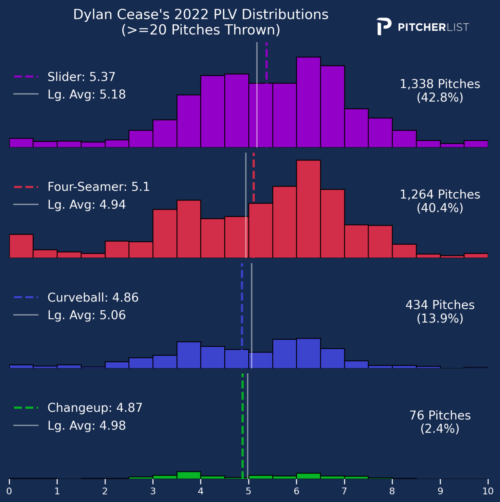This past offseason, Pitcher List introduced Pitch Level Value, or PLV, a new set of comprehensive metrics that assess player performance by grading outcomes on the single pitch level. If you’re new to it all, be sure to read Nick Pollack’s primer on PLV here.
With six weeks in the books, we’ve got a good sample size for PLV, PLA, and pitch type PLA so we can start to feel fairly confident about how things stand with many pitchers, ie more signal and less noise. As a reminder, PLV and PLA start to become less noisy at around 500 pitches. For reference, below you’ll find the PLA definitions straight from the PLV app.
Pitch Level Average (PLA): Value of all pitches (ERA Scale), using IP and the total predicted run value of pitches thrown.
Pitchtype PLA: Value of a given pitch type (ERA scale), using total predicted run values and an IP proxy for that pitch type (pitch usage % x Total IP).
This week, we’ll take a look at three pitchers who have done really well lately and two that have gotten off to dreadful starts.
(Note: All PLV data is current through Thursday 5/11).
This past Monday, Keller bulldozed the Rockies en route to the first shutout thrown by a Pirate since Jameson Taillon in 2018. Not bad. He now has a 2.72 ERA, 1.09 WHIP, and a 20.7% K-BB%, all career-bests outside the 21.6% K-BB% he posted in his rookie season back in 2019.
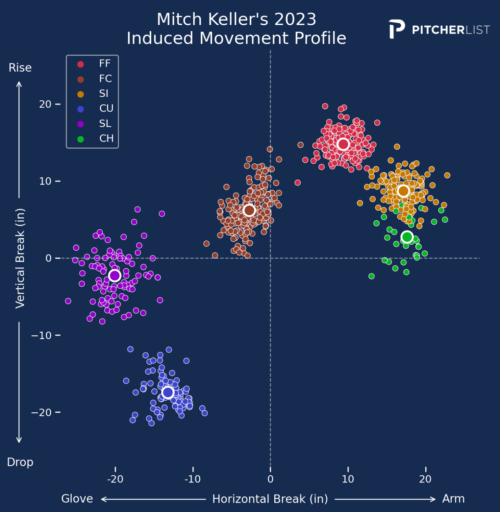
Now equipped with a cutter, Keller’s approach is uniquely eclectic. You can see his induced movement profile above which is more or less a way to visualize that he can come at hitters from all different angles. He seems to be embracing the Yu Darvish method which is to say he’s throwing a bunch of different pitches. Granted, that doesn’t work for everyone as we’ve seen plenty of examples where adding a pitch actually leads to diminishing returns. But Keller’s results speak for themself. He knows what he’s doing and if he doesn’t, it’s a brilliant con job.
A couple of random things stood out to me about Keller: His four-seam fastball has netted a 16.3% SwStr up from 11.4% last year. Maybe his new cutter is making the fastball play better?
And second, check out his slider plot. Terrific glove-side command against righties. Keller’s slider has earned a 1.78 PLA, that’s seventh among pitchers with at least 500 pitches thrown.
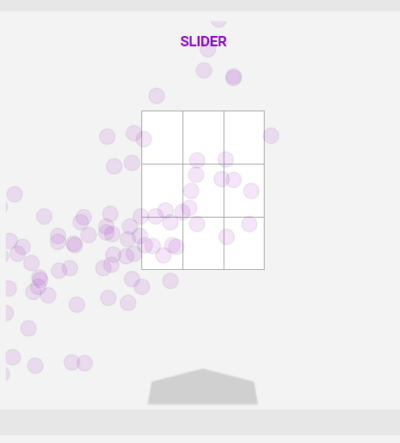
Lefties have terrorized Keller for his career. Last year, the batted-ball results weren’t quite as bad against left-handers, but it was still a clear weakness: A 6.4% K-BB% versus LHB as opposed to 16% against RHB. This year? A 21.6% K-BB% versus LHB and 19.6% against RHB. Great improvement. This year, Keller’s new cutter has actually allowed a .353 wOBA to LHB. I was a little surprised by that and guessed that it had gotten better results. Anyway, what does PLV say?
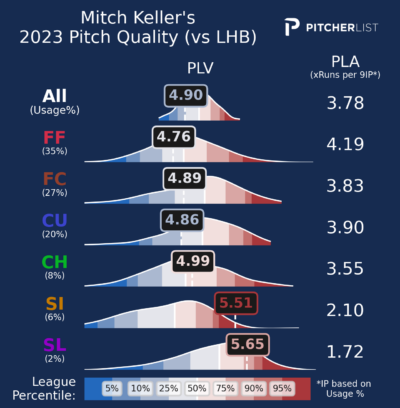
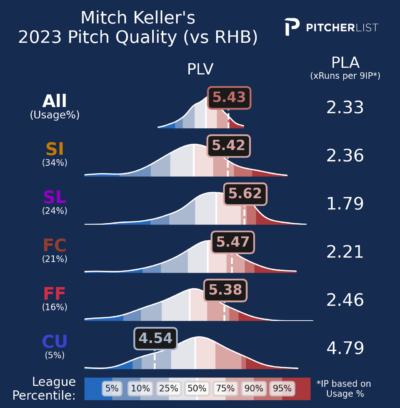
Against righties, he’s really good. Lefties might still be an issue though. So far Keller has held LHB to a .202 average and .268 wOBA. But PLV suggests at least some regression on that front. For reference, here’s his pitch quality distribution against LHB from last season.

His fastball has performed a little better against LHB this year with a 4.19 PLA relative to last year’s 4.41 but basically, this is telling us that it still grades about average. It’s a similar story with his curveball and changeup. The new cutter grades about average against lefties too with a 4.89 PLV and 3.83 PLA. This is all to say that Keller has shown some improvement against lefties but probably not quite as much as the results would seem to indicate.
If you are one who enjoys playing the buy-low/sell-high game, now might not be a bad time to go fishing considering how good the recent results have been. However, I’m not expecting the roof to cave in. Sure, lefties might be due to hit him a little bit better but he’s also done a lot of good things, including a career-low 6.9% BB rate all illustrated by an overall 5.16 PLV and 3.08 PLA, a significant bump up from last year’s 4.92 PLV and 3.85 PLA.
Another great outing from Cobb this past Thursday against the D-Backs drops his ERA to 1.70 along with a 1.24 WHIP. The latter combined with a K rate of 21%, basically league-average, implies at least a decent amount of good fortune. Below, you’ll find his pitch quality from this year and last year for comparison.
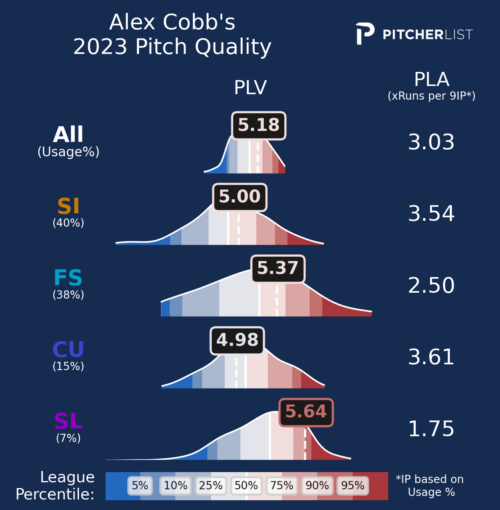
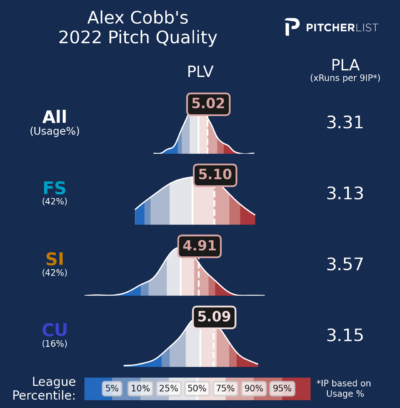
Cobb’s new slider grades out exceptionally well with a 1.75 PLA. That’s actually tied with Gerrit Cole, and George Kirby for fourth among pitchers with at least 500 pitches thrown. And it leads his arsenal with a 14.5% SwStr rate, the only problem is he’s only throwing it 7% of the time, limiting its impact.
Cobb’s sinker still rates out about league average with a 3.54 PLA, and only marginally better than last year’s 3.57. The curveball is slightly below-average and a little bit worse relative to last season.
But what’s really fueling the charge is the splitter. ‘The Thing’ has returned a relatively modest 13% SwStr rate, but the big difference seems to be a jump in zone rate from 29.8% to 37.7% which has helped him shrink his walk rate to what would be a career-low 4.1%. That’s kind of neat to see from a splitter. For reference, Kevin Gausman and Taijuan Walker have splitter zone rates of 18% and 28.6% respectively this year. The fact that Cobb is also getting a chase rate of over 40% with his splitter illustrates his exceptional command.
All this is to say that Cobb’s splitter is very good. No, not exactly a new development but, I think it’s just cool to see him put it all together after the injuries he has dealt with all while adding a slider no less. Similar to Keller, Cobb’s overall PLA of 3.03 points to this being a high point, but he’s also done some good things to get here.
Eovaldi kept rolling with a dominant start against Oakland this past Thursday which included a career-best 12 punchouts backed by a 36.3% CSW. Sure, it’s Oakland but it’s hard to ignore someone who goes eight-plus innings in three consecutive outings.
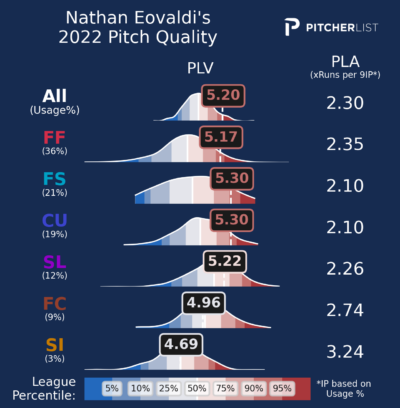
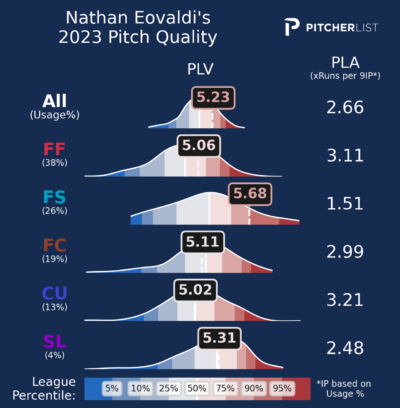
Injuries held Eovaldi to just 20 starts last year, but his PLV grades were exemplary across the board. This year, his splitter has been absolutely filthy. Among pitchers with at least 500 pitches, he’s got the best splitter with a 1.51 PLA. Kodai Senga is second at 1.75.
However, his fastball, curve, and cutter all graded out better last year which is maybe a little surprising. He is throwing his cutter a bit more this year, but it’s been just about average to slightly below average by PLV.
Either way, of the three pitchers we’ve reviewed, Eovaldi grades out the best. This year, he’s got a 2.59 PLA against RHB and a 2.75 PLA against LHB. Overall, his 2.66 PLA is 15th among all pitchers with at least 500 pitches thrown.
First off, happy birthday to Lance Lynn, who turned 36 on Friday. Unfortunately, the celebrating ends there as he now owns the highest ERA among qualified starters at 7.51. Jordan Lyles is second at 6.20. So is this the end for him?
The weird thing is that he’s still missing plenty of bats. His current K rate of 26.9% is similar to the 27.5% two years ago, the season in which he posted a 2.69 ERA and 1.07 WHIP across 28 starts, ie the peak Lance Lynn experience. Let’s compare the two.
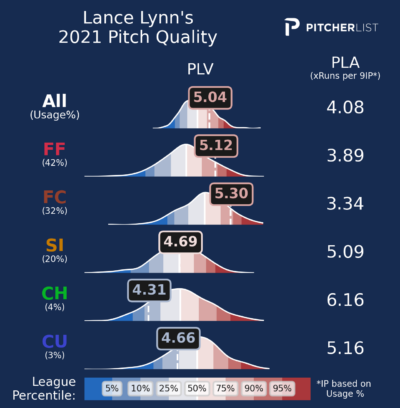
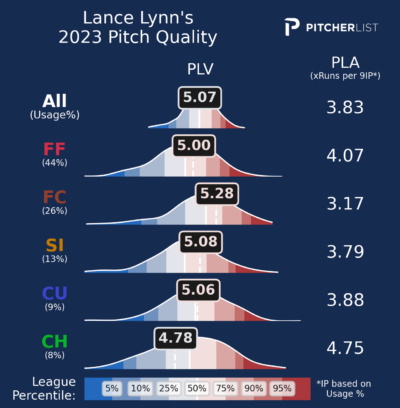
This is interesting. The surprise here for me is double. One, I kind of expected his grades from 2021 to be a little bit better than they actually were given the stellar results. So it looks like there was a fair bit of overperforming going on. The second surprise was that I expected his grades this year to be far worse. But they’re fairly similar.
The one notable drop-off is with his four-seamer dipping from a 5.12 PLV/ 3.88 PLA to a 5.00 PLV/ 4.07 PLA. The drop in velocity is hard to ignore. This year, he’s averaging 92.2 with the four-seamer as opposed to 94 in 2021. However, his four-seamer has still netted a 90th percentile SwStr% rate of 15.1% despite the loss in velocity. That’s not too far off the 17% he posted in 2021.
I can’t discount the drop in velocity, that’s point blank very concerning for someone who relies so heavily on their fastball. So maybe this is the beginning of the end. But I’m a little intrigued by him as a bounce-back candidate because his cutter still grades out well, and pretty close to where it was two years ago. This year it’s returned a 16.7% SwStr % compared to 12.8% in 2021. All told, I still think Lynn has a decent shot at rebounding, say with around a 4.00 ERA which might make him a decent buy-low considering he’s still missing bats at a good rate.
We’ll end with another White Sox pitcher who has a rough go of it, to say the least. The surprising thing, for me at least, is that I expected Cease’s fastball to be the biggest problem. That’s part of it but maybe the more notable difference is in his slider, you can visualize its PLV distributions below. Just a less optimal distribution of sliders as it seems like it’s backed up on him more frequently this year (bottom) compared to 2022 (top). The result has been a drop in slider pitch quality from a 5.50 PLV and 2.39 PLA to a 5.12 PLV and 3.98 PLA.
